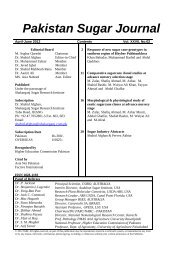Jul-Sep 2012 - Shakarganj
Jul-Sep 2012 - Shakarganj
Jul-Sep 2012 - Shakarganj
Create successful ePaper yourself
Turn your PDF publications into a flip-book with our unique Google optimized e-Paper software.
Faqir Hussain et al.<br />
Before sowing, double budded setts were cut, stored under cane trash to check evaporation and<br />
sown @ 80,000 DBS ha -1 . The germination and tillers per plant were recorded 45 and 90 DAS<br />
while yield was noted at harvest. CCS and sugar recovery were calculated by crushing one<br />
composite sample from each replication of each treatment according to procedures laid out in<br />
Sugarcane Laboratory Manual for Queensland Sugar Mills (1970). All the qualitative and<br />
quantitative treatment means were subjected to statistical analysis to judge their superiority<br />
(Steel and Torrie, 1980).<br />
The details of treatments are as follows:<br />
T1= Fresh cane setts used for sowing<br />
T2= Tree days stale cane setts used for sowing<br />
T3= Six days stale cane setts used for sowing<br />
T4= Nine days stale cane setts used for sowing<br />
T5= Twelve days stale cane setts used for sowing<br />
RESULTS AND DISCUSSION<br />
Germination: A decrease in germination percentage with increasing seed setts’ staleness was<br />
recorded in both varieties .In HSF-242, maximum germination (39.20%) was recorded in T1<br />
while minimum (21.58%) in T5. Similarly maximum germination in CPF-236 was noticed in T1<br />
(37.26%) while minimum in T5 (17.50%). These results confirm Yadava (1991) who stated that<br />
older buds were relatively less successful.<br />
Tillers per plant: A trend analogous to germination was also found in tillers per plant in both<br />
varieties. Average tillering data envisaged, maximum number of tillers per plant (2.08) in T1<br />
where fresh cane seed setts were sown and minimum in T5 (1.77) where 12 days old setts were<br />
used .Higher tillering due to higher germination was also examined by Ali et al., (1999) while<br />
studying the performance of different sugarcane varieties.<br />
Cane yield: Tabulated data showed that cane yield was directly affected by germination and<br />
tillering. A higher germination and tillering produced heavy tonnage and vice versa. Twelve days<br />
stale seed gave minimum yield 38.34, 39.73 and 39.04 tha -1 in HSF-242, CPF-236 and on<br />
average basis respectively. Highest germination produced highest cane yield and highest tillering<br />
gave rise to highest yield was also investigated by Bajwa et al., (1993) and Atta et al., (1992) in<br />
their separate studies of sugarcane varietals trial.<br />
CCS and sugar recovery: Results showed that both CCS and sugar recovery were interrelated<br />
with each other with respect to increasing and decreasing trend but not with germination,<br />
tillering and yield. The maximum CCS, on average basis, was noticed in T2 (14.33%) and it was<br />
followed by T3 (13.47%), T1 (13.42%), T4 (13.41%) and T5 (13.120%) in descending order.<br />
Similar trend was recorded in sugar recovery. Bajwa et al., (1993) also noticed same<br />
observations while studying performance of twelve varieties that CCS was independent of<br />
germination and yield.<br />
Pakistan Sugar Journal <strong>Jul</strong>y-<strong>Sep</strong>t. <strong>2012</strong> 14






